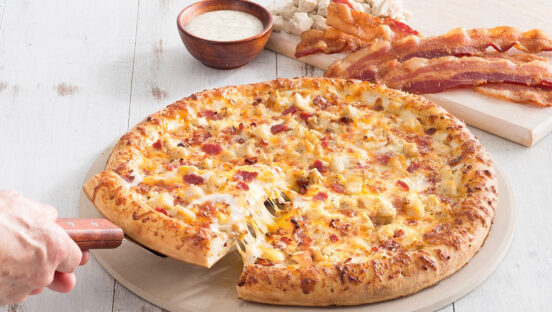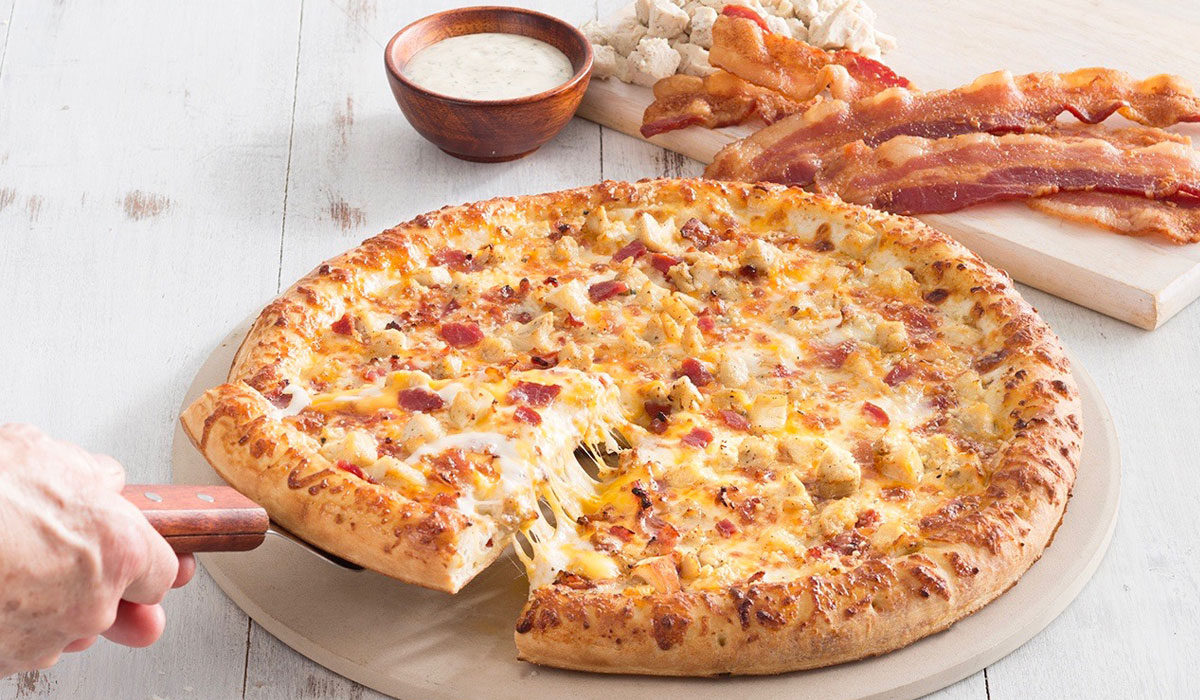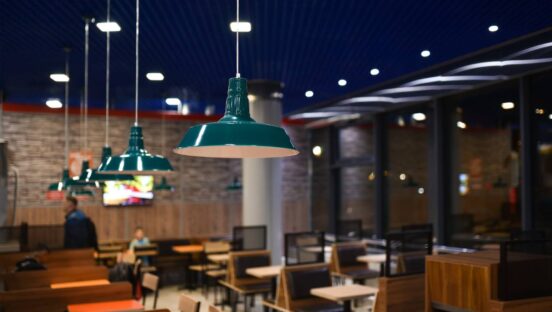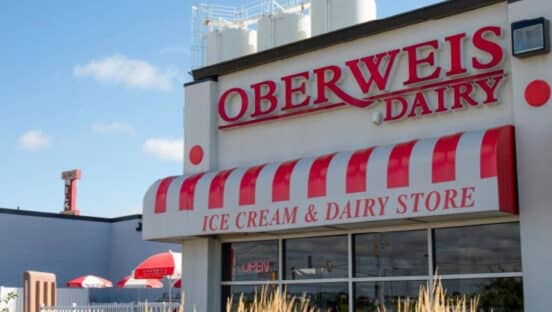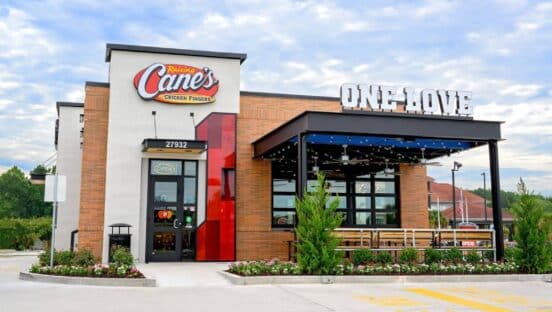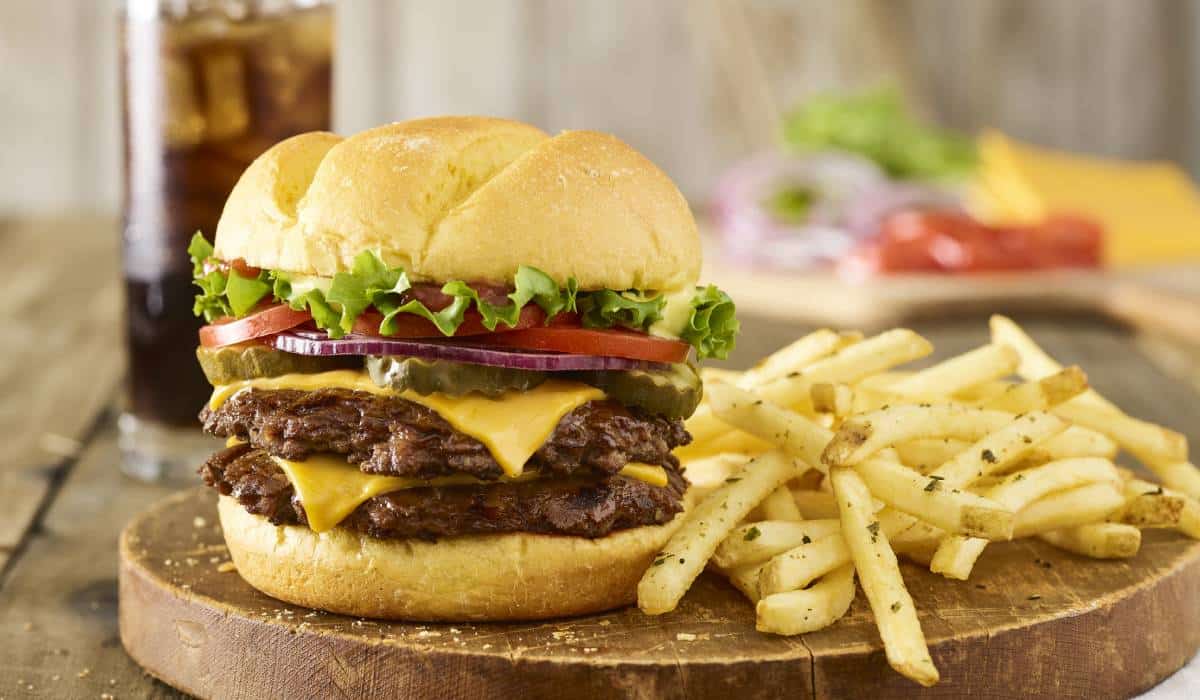Later this year, Zaucer Pizza co-CEO Aaron Roberts will begin testing an artificial intelligence–equipped pizza-making platform in his Washington state restaurants. The new tech—created by Seattle startup Picnic—will give personal-pie brand Zaucer the ability to produce up to 300 12-inch pizzas in one hour.
“I would need probably five or six people giving 100 percent effort to keep up with that number otherwise,” Roberts says.
Roberts—a restaurant technologist as well as pizza maker—has been in talks with Picnic about their platform for a few years now. He says that, before Picnic reached out about the new tech, he’d been pondering the possibilities of AI-enabled pizza-prep for quite some time, thinking it could decrease portioning errors and free up human employees for more customer-facing tasks.
The Picnic platform is slightly smaller than Roberts’ usual 12-foot-long make lines and promises all of Roberts’ hoped outcomes for the sci-fi-inspired Zaucer chain. He will begin testing the tech with large orders only, sending specifics to the machine via Zaucer’s cloud-based point-of-sale system, and letting it sense and place the correct amount of sauce, cheese, and toppings on dough.
“We’re excited about it, the staff is excited about it, and the customers are excited, too,” Roberts says. “It’s going to be an exciting year for us; if the system works out as I expect, my goal is to grow our brand using this technology.”
AI is no longer a futuristic daydream for the quick-serve industry. The technology—while arguably in its early days—has already landed in the foodservice space. McDonald’s made waves by buying two AI-focused companies last year, Dynamic Yield and Apprente, with the eventual intention of automating the drive-thru and more. Chick-fil-A uses AI to monitor social media for rumblings of foodborne illnesses.
Domino’s has been exploring AI for some five years and is testing its voice-ordering assistant, DOM, in 40 stores, as well as using the tech for social media and rewards programs.
AI is here, and it’s much less frightening (or, for some, less exciting) than a host of robots sweeping in and preparing food.

The tech
AI doesn’t take one form but many, existing as a labyrinthine set of technologies that can be utilized in nearly any point of restaurant operations. “AI is essentially an umbrella term. There are very specific components under the surface that are very different from each other, but all of those things will find themselves integrated into every part of operations in the future,” says Rob Carpenter, CEO of Valyant AI, a conversational AI company that has been working with chains such as Good Times Burgers & Frozen Custard to automate customer orders.
Valyant’s technology functions similar to Amazon’s Alexa or Apple’s Siri, but for brands rather than consumers. The platform, Holly, is able to take orders from guests, gathering customer information during the ordering process and then offering upsells that can bulk up profits.
Good Times began using the platform to take breakfast orders in January 2019, eventually expanding Holly to take lunch and dinner orders, too. In July, the brand reported an average 6 percent increase in spend per order through Holly, as well as an average attempted upsell success rate of 40 percent. The platform was also reported to cut the average customer wait time by 10–25 percent.
“One of the most critical value propositions is that our platform helps decrease wait times—you run the drive thru faster,” Carpenter says. “This also automates a task that most employees don’t want to do. It also helps from an upsell perspective; AI never gets bored or discouraged, and even if two customers in a row say no, it will continue to upsell everything.”
Domino’s was an early adopter of conversational AI technology. Thanks to DOM, customers are able to order online, in-app, or via Amazon Alexa or similar devices with a simple voice command. The aforementioned 40-unit in-store test of using DOM for phone orders could lead to system-wide adoption of this in the future; meaning that DOM would take care of in-store orders, too, and free up team members to attend to the pizza make lines and interact face-to-face with customers who come in to place or pick up orders.
The chain isn’t limiting AI to ordering. Last year, the Points for Pies promotion allowed customers to submit a photo of any pizza from any brand and receive Domino’s rewards points. AI identified pizzas in the photos, quickly selecting the customers eligible for the rewards. Domino’s chief digital officer Dennis Maloney says the company plans to continue exploring the tech.
“This is definitely something that’s part of our business—it’s not new for us, it’s established to the point that we’re building specific teams that are dedicated to understanding how to use this technology,” he says.
And then, of course, there’s AI that resides in the kitchen. Instead of streamlining ordering and other customer interactions, this stable of AI tech is aimed at increasing product consistency, slimming down makeline and prep labor, and automating other back-of-house operations.
Picnic is one of these platforms. The tech assembles pizza right now, but Picnic CEO Clayton Wood says the future will include other foods, too. The process is simple: Pre-made and pre-stretched dough blanks are placed on the machine’s conveyer belt, where they are topped with the perfect amount of sauce, cheese, and toppings. No oven is involved in the process, and the pizzas come out ready to be cooked. AI takes the place of a trained pizza prep employee, identifying the correct portion and distribution of the ingredients.
Wood says future iterations would follow a similar process for foods like burgers and tacos, topping patties with mustard or ketchup or tortillas with refried beans. The system is modular, meaning that each ingredient (i.e. pizza sauce or cheese) has its own individual operation and distribution mechanism that could easily be dedicated to a different ingredient.
“We do the assembly, which is the part of the prep process that requires training. We started with pizza restaurants because there’s a labor problem there—rush hour at a pizza restaurant requires a lot of employees, and it is a particularly labor-intensive food,” Wood says.

The operators
Zaucer, along with event hospitality company Centerplate, is one of the first two brands testing Picnic. The system fits well in Zaucer because it fits well with owner Roberts’ areas of expertise—pizza and tech. Roberts has already had extensive experience with the platform, having tested out its functions and the pizza product it makes before it landed in his store.
The machine will require only minimal employee training centered on how to clean its components (it can be taken apart and safely washed in a standard commercial dishwasher). Despite the simplicity of the system, Roberts expects big returns.
“With a machine like this, you can certainly do much higher volumes. I can use the employees I already have more efficiently; they can focus on customer service, make sure guests are having a great experience, and make the raw ingredients to put in the machine,” he says.
Dickey’s Barbecue Pit has customer-facing AI in the works that will allow guests to place online orders and ask questions hands-free through a chatbot. The update will roll out some time in the next year, together with the brand’s website revamp, and could potentially be rolled over to in-store kiosks in the future.
These updates aren’t the chain’s first foray into AI. A 2016 initiative already brought the technology to the brand’s Pit Crews (team members) in the form of a chatbot piece built by Dickey’s through a partnership with big data and analytics company iOlap. With the system, operators and team members can talk to their data and gain information about in-store processes and operations (such as how much cook time is left for an ingredient) without stopping their work to engage with a tablet.
The conversational AI platform is available to all operators, but isn’t required, which is crucial in making sure that operators are comfortable in their units, says Dickey’s CEO Laura Rea Dickey, who was formerly head of the brand’s tech team.
“Our center point is: How can we use big data to make better barbecue? There’s a tendency in tech to be drawn to what’s new or shiny, but we focus on the end-user benefit,” she says. “We’re looking for ease of use. We let our operators choose if they want to adopt the tech or not.”
The brand has an IT committee built with franchisees so that operators are informed of all new initiatives, and the VP of information technology, Carissa de Santis, has a bevy of experience in restaurant operations to ensure that updates are both useful and accessible for team members.
“It’s not just about cool tech; we look at all innovations and ask if it makes sense for us,” de Santis says.
Of course, aside from a necessary learning curve, the cost of the technology also affects operators. This is, again, where Dickey’s optional AI comes in handy, allowing franchisees to make the best decisions based on their individual finances.
IBM Research has been exploring AI for years, and offers platforms like Watson Assistant, a service that allows operators to incorporate conversational AI into any product. IBM Watson go-to-market and strategy lead Fredrik Tunvall says most brands that use Watson for 24/7 customer service assistance or other customer-facing roles say that their guests have an improved customer experience. He says that automating simple questions can help use human labor more efficiently, too. But he realizes that acquiring and implementing the tech that generates these benefits can be daunting.
“AI is here to help you—it’s here to make you smarter,” he says. “There are a lot of free services to start with. Start small and find the business value, and then expand from that.”
All of IBM’s AI services are cloud-based, and smaller versions are available to operators for free, giving brands time to learn the platforms without taking a high financial risk.

The results
With a list of quick-serve giants already on board, smaller brands stepping up to the plate, and other industries adopting AI at lightning speed, it’s clear that the technology has arrived and demands a response from those in foodservice.
“People were asking how big mobile phones were going to be a decade ago, and now mobile phones are everywhere,” Domino’s Maloney says. “The same question is being asked about AI now, but it’s not even a question anymore. It’s becoming a core component.”
Of course, even with available tech and willing operators, there is still one involved party to consider when it comes to AI and foodservice: the customers. Do customers trust AI yet? Are they willing to put their food in non-human hands?
The answer to both questions is probably yes. While AI is still new tech and can be unnerving, it’s already incorporated into technology that most people use every day (i.e. Alexa and Siri), meaning that customers are more familiar with AI than they might realize.
Zaucer’s Roberts says that, while he hasn’t begun publicizing the Picnic platform to guests and plans not to until the tech is fully incorporated into his operations, several customers have caught wind of the platform through other press and have approached him with their excitement. He says the secret to good pizza is in the sauce and the crust, meaning that the functions that Picnic will perform will make pizza faster and more correct for guests, but not change the taste or quality of their product.
Dickey’s team says data security is top of mind as they roll out fresh AI innovations, and that they will gauge customer reactions toward their chatbot ordering platform once it’s available online. But Dickey and de Santis also say they know that, in 2020, consumers are already using AI on a daily basis.
“All the smart brands will adopt this, because it’s just so commonplace now. So much AI is already out there for customers that you don’t even realize exists,” de Santis says.
At this point, the key is wisdom—approaching AI with a self-awareness of your brand and your customers, but approaching it nonetheless. The tech landscape of today requires operators to respond to AI, either now or in the near future.
“Adoption of AI has been slow in the restaurant industry compared to other industries, but we believe that, starting this year, it’s going to explode,” IBM’s Tunvall says. “So if a brand in the restaurant space doesn’t adopt it, their competitors will.”

